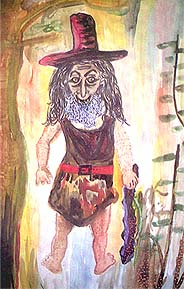Bigfoot Encounters
El Tata Duende, or Dwendi, Dwendis
The translation is "goblin, elf"
"El Duende"
A San Pedro Folklore
by BY ANGEL NUÑEZ
"Do not go to the bush to cut firewood nor look for coconut husks, or El Dueno del Monte" will get you". This was a common threat in the 1940's and 50's which mom would use when she needed the children at home for some chores rather than going to the bush. The children, of course, preferred going to the bush for the thrill of some adventure. It was not that they liked cutting firewood, but hunting for bird nests and raiding the eggs was a thrill in itself. It also meant drinking fresh coconut water or hunting for coco plums or sea grapes. A trip to the bush could also run you the luck of killing some wild bird, a bush hog or even a deer. Now that was indeed a thrill.
El Tata Duende
 (Illustration from - Characters & Caricatures in Belizean Folklore)
(Illustration from - Characters & Caricatures in Belizean Folklore)
So how could mom's funny threats about El Dueno del Monte scare anyone and keep him out of the bush? El Dueno del Monte was another name given to El Duende. Those who saw him said he was about 3 feet tall and wore a wide brimmed hat. Sometimes he wore a red hat and animal skins for clothing. Dad said that El Duende protected the animals in the bush and would get very angry when little boys killed birds without a reason. Mom said one could kill a bird if he would eat it, but to shoot one with a sling shot just to prove one's talent was wrong. El Duende was a daytime creature and would roam the bush and watch you mysteriously if you were killing animals.
Sometimes El Duende would get tired and sit at the foot of a tree and fall asleep. He would transform itself into red clay. Anyone spotting it would think it was some Maya artifact, but if you took it home, he would escape during the night. Therefore you can bet your sweet lip that if we found a clay figurine in the bush, we would not even touch it.
What happened if the Duende caught you in the bush? Well, he would take you to his dwelling, which was a spot deeper in the woods, probably a cave. But there was a way to escape him. He only had four fingers, and no thumb, so if surprised by him, you could hide your thumb in the palm of your hands and he would think you are one of his, and he would leave you unharmed. In this respect, El Duende was just like the Sisimito, another folklore character in San Pedro. Most of the evil characters were scared away if you made the sign of the cross with sticks or even with your fingers, but El Duende was not an evil character, so he was not scared away by "the cross". In fact, El Duende was a friendly character and only punished you if you were killing too many animals or doing mischief in the bush. He would be frequently spotted especially during the Lenten Season and especially on Good Fridays.
El Duende was identified by a piercing whistling, and that was his weakness. Anyone whistling in the bush was a target of an attack by him. That is why dad used to say: "Never whistle while you are in the bush, or you will be calling on the Duende to attack you." Twenty five years ago, if anyone saw a strange man in the village and he would ask you to follow him, you can be sure that no one did for fear that he could be the infamous Duende.
-0-
And this out-take from Michael Cremo's Forbidden Archaeology: People in
The name Dwendi comes from the Spanish word Duende, meaning "goblin." Ivan Sanderson, who conducted research in Belize, wrote (1961, pp. 164-165): "Dozens told me of having seen them, and these were mostly men of substance who had worked for responsible organizations like the Forestry Department and who had, in several cases, been schooled or trained either in Europe or the United States. One, a junior forestry officer born locally, described in great detail two of these little creatures that he had suddenly noticed quietly watching him on several occasions at the edge of the forestry reserve near the foot of the
The Dwendis appear to represent a species different from the large Sasquatch of the Pacific Northwest of North America.
The excerpt is from "Forbidden Archaeology: The Hidden History of the Human Race'
Back to Creatures?
Back to Stories
Back to Bigfoot Encounters Main page
Back to Newspaper & Magazine Articles
Back to Bigfoot Encounters "What's New" page
Portions of this website are reprinted and sometimes edited to fit the standards of this website
under the Fair Use Doctrine of International Copyright Law
as educational material without benefit of financial gain.
http://www4.law.cornell.edu/uscode/17/107.html
This proviso is applicable throughout the entire Bigfoot Encounters Website.